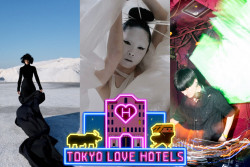
October 29, 2009
Pole Dancing Goes Straight
The once ‘exotic’ dance form is now for every kind of gal—and guy
By Metropolis
Originally published on metropolis.co.jp on October 2009

Courtesy of IPDFA
My pulse quickens as I’m about to meet up with the coordinator of the International Pole Dance Fitness Association to talk about the organization’s upcoming Tokyo championship. And when Ania Przeplasko sits opposite me in a Metropolis conference room, it’s clear there is a shapely, toned bod inside her no-nonsense blouse and skirt.
But friendly as Przeplasko may be, she’s all business, and—ahem—so am I. For this is pole dance 2.0. Banish those fantasies of shimmying buttocks and come-hither glances; replace them with images of sixpack abs, women’s lib and celebrity appearances on Oprah.
Building on years of momentum that have seen pole dance repurposed by a new generation of women as a form of exercise and self-expression (global pole fitness classes are up 4,000 percent since 2003), the IPDFA held its first international championship in Manila last year. The event, says Przeplasko, was transformational.
“At first it was difficult to get sponsors,” she explains. “But after the competition, the image of pole dance—which in Manila was still strongly associated with prostitution—changed drastically. We were surprised by the media response.”
After viewing dozens of performances, judges selected winners from the US, Philippines and Japan in three categories: Pole Dance, Pole Art and Pole Fit. Performances are judged on both technical and creative merits, and dancers must also adhere to a strict set of guidelines forbidding them from conversing with the audience or giving “the effect of excessive nudity and explicit content inappropriate for an athletic dance sport.”
Przeplasko herself first got into pole dancing when she arrived here from Poland—hold the puns, please!—to design clothes a decade ago. With a background in gymnastics and a love of fashion, it was a perfect fit. As IPDFA coordinator, she says the decision to hold the second championship in Tokyo was a natural one.
“Tokyo is Tokyo, and it excites the competitors,” she says. “The pole dance trends here are the most artistic, and the studios are the most professional. Japanese girls have a problem with shyness, and pole dancing has helped their confidence. I can see the change.”
The 2009 finals will see performers from Brazil to Moldova converge on Tokyo—and, for the first time, men will be among their ranks.
“As a leisure activity, it appeals more to women than men because some movements are inspired by exotic dance elements which embrace strength in femininity,” Przeplasko explains. “However, the Chinese Pole, which has begun to cross over into mainstream pole dancing, has been dominated for centuries by all-male Chinese state circus troupes. This has led to a rise in men undertaking pole dancing.”
Images of muscled men and bossy women don’t exactly excite the libido of this insecure male, but apparently all is not lost. “While pole dance as an erotic dance is shying away, and increasing as an exercise and art, it doesn’t mean that it is losing its sensuality,” Przeplasko insists, offering comfort. “As a performing art, pole dance is an esthetic dance where the artist makes graceful movements in a sensual style.”
International Pole Dance Fitness Championship Tokyo 2009
International pole dancing event with various dancers competing, this year including men. Dec 3, 7:30pm, ¥4500 (with complimentary appetizer and cocktail) ¥10000 (VIP Lounge seating with dinner and complimentary glass of champagne) Christon Café
Levels 8 and 9. Oriental Wave building. 5-17-13 Shinjuku Tokyo Japan, for more information: www.polechampionship.com







